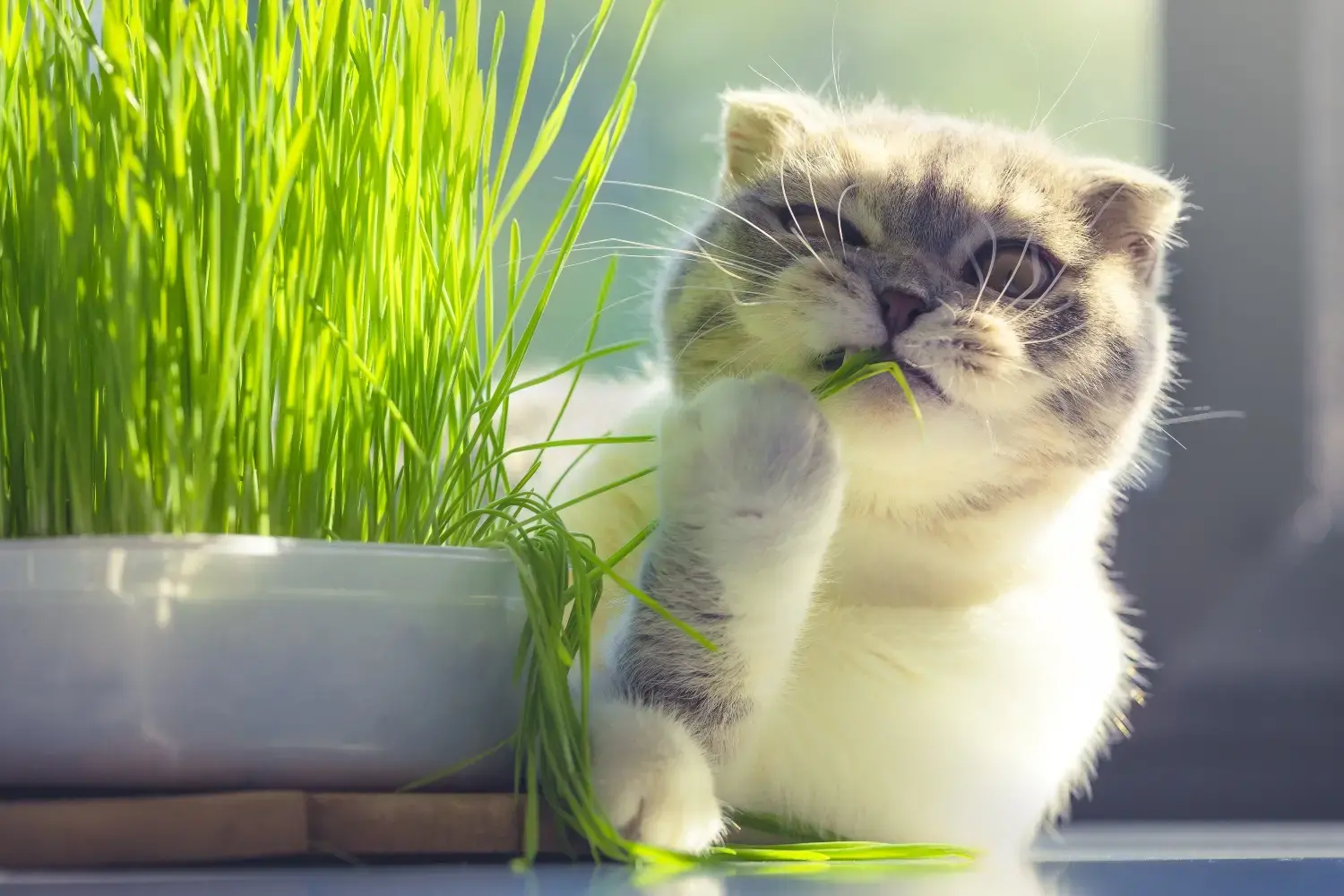
If you’ve ever caught your cat chomping away at your houseplants or munching on blades of grass outside, then cat grass might be the perfect solution to redirect this natural behaviour. Learn more about cat grass and its benefits to see if it's the right fit for your kitty.
Many cats have a natural affinity for plants and grass, but they aren't always the healthiest options. Whether they are snacking on potentially toxic succulents or ingesting some grass from the yard (and horking it back up), eating whatever plant life strikes their fancy can lead to some unwanted consequences.
Instead of letting them nibble on questionable sources, opt for digestion-friendly cat grass to help your cat explore this natural instinct.
Let’s take a close look at cat grass, explore why so many cats crave it, and how you can safely grow it at home.
What Is Cat Grass?
Cat grass isn’t a specific plant. It's actually a name used to refer to the sprouts of certain cereal grains that are safe for cats to consume. Though it looks much like regular grass, it is nutritionally very different.
Cat grass can be sourced from a single type of cereal grain or a mixture of a few.
The most common sources of commercially sold cat grass are:
-
- Wheat
- Oat
- Barley
- Rye
You might see it sold as a little pot of vibrant green shoots or as seeds ready for planting. Unlike the lawn grass outside, which can be treated with fertilizers and chemicals, cat grass is grown specifically for cats to nibble on, making it a safer, healthier option for indoor kitties that is completely chemical-free.
Why Do Cats Eat Grass?

Cats are mysterious creatures with each their own quirks, but their love for grass is surprisingly common - all cats seem to love to nibble tasty greens. Even the most pampered indoor cats go a little wild at the sight of a fresh patch of grass.
What is it about grass that makes cats feel the need to nibble? Is it the taste? The texture? Or maybe they know something we don't?
There are actually a variety of reasons that cats are drawn to grass, leaves, and other plants, and the different reasons could help you determine if cat grass is a good choice, choose the best times and ways to eat it, and even help you select the types of cat grass that will be the most beneficial.
Some cats treat grass like salad, they enjoy grazing on it. Others treat it like medicine when their tummies are upset. And some just like to play with it before taking a nibble. There’s no one-size-fits-all answer, but it’s usually harmless and often beneficial when offered in moderation.
Why Do Cats Eat Grass and Vomit?
If your cat eats grass and promptly throws it back up, it's understandable to think that maybe grass is bad for them, right?
But before you panic, it's important to understand the type of grass they are eating and why they are eating it.
If your cat has a tendency to snack on the lawn or taste test your indoor plants, their proclivity towards regurgitation might be due to the fact that these plant materials just aren't great for digestion, and in some cases, toxic.
Even when eating cat grass, some cats still tend to throw up because, as carnivores, cats don't digest plant material very effectively. This may sound like a bad thing, but the instinct to eat grass is very likely a way for your cat to help settle their stomach, facilitate healthier hairball excretion, and generally improve digestion.
This may seem sophisticated for a cat that chases its own tail or stretches too hard and rolls off chairs, but it's just instinct. Nature's detox, in a way.
Why Do Cats Like Cat Grass?
Cat grass has a strange hold over even the most dignified felines. One whiff, and suddenly your aloof indoor cat is face-deep in a patch of greenery, munching away like a lawn mower. But what’s behind this grass obsession?
It turns out that cats aren’t in it for the flavour alone. While different types of grass may vary slightly in taste or texture, most cats like cat grass for reasons that go far beyond their need to feed. Whether they’re seeking out nutrients, instinctively mimicking wild behaviours, or simply enjoying the sensory stimulation, cat grass taps into something deeper.
Here are the most likely reasons your cat loves cat grass:
Instinctual Behaviour
Cats are carnivores, but even their wild counterparts seek out some plant fibre to complete their diet. Grass is one of the easiest to source options for cats looking to support digestion. Even if your cat is eating a well-balanced and complete diet, the instinct to eat grass is deeply ingrained in their genes.
A Source of Nutrients
Grass contains folic acid, a vitamin found in their mother’s milk that helps oxygen move through the bloodstream. Some experts think cats might chew grass to top up on this essential nutrient. While this isn't proven, many cat grasses do contain helpful nutrients that can be beneficial to your cat's health.
Digestive Help
Eating grass can help a cat pass hairballs or other indigestible materials. Sometimes, it acts like a natural laxative—or causes vomiting to clear out what doesn’t belong. This ties into that natural instinct that cats have, even if they don't know why they are doing it.
Makes Indoor Cats Happy
Indoor cats can benefit greatly from being offered a little patch of cat grass. While indoor cats do tend to live longer than outdoor cats, it doesn't mean they don't long for a little taste of nature. Cat grass can help reduce behaviours like trying to escape, clawing at windows, and more signs they are curious about outside.
Cat Grass Benefits
So, aside from the occasional puke-fest, is cat grass good for cats?
Yes, when grown safely and offered in moderation, cat grass can be a regular and beneficial part of your cat's diet and routine. Whether they casually nibble, chow down, or just play with it, cat grass can help your cat be healthier and happier.
Here are some top benefits of cat grass:
-
- A natural source of fibre that can help with digestion
- Hairball management (a big win during shedding season!)
- Mental stimulation and enrichment, especially for indoor cats
- Safe chewing alternative to your houseplants (RIP to the ficus)
Overall, cat grass is a low-maintenance way to satisfy your cat’s instincts while promoting health and well-being.
Is Cat Grass Safe?
If cat grass makes your cat hurl, then can it really be that good for them?
Surprisingly yes! Cat grass is safe and encouraged for most cats, but keep a few tips in mind:
-
- Avoid outdoor grass or garden trimmings. They might contain pesticides, fertilizers, or toxic plants.
- Moderation is key. A little nibble here and there is great, but too much can cause stomach upset.
- Watch for mould. Cat grass should be fresh and green. If it starts yellowing or growing mould, replace it.
- Feed the grass, not the seeds. Don't offer your cat cat grass until it's sprouted and grown at least 2 inches tall.
Like most things, anything your cat eats has the potential to be harmful if not fed properly. Offering too much cat grass, especially if your cat is a competitive eater, can lead to more of the issues you are trying to solve.
You may need to offer cat grass for a limited amount of time, rather than leaving it out for your cat 24/7, or keep it in a place where you can easily monitor their consumption.
Types of Cat Grass
All cat grasses are not the same. They may look the same, but the nutritional benefits and flavour will change depending on what type of cereal grain they sprout from.
Let’s break down the most common types of cat grass you’ll find in stores or grow-at-home kits:
- Wheatgrass – The most common cat grass. Rich in nutrients and easy to grow.
- Oat grass – Sweet-tasting and high in fibre.
- Barley grass – Often darker green and a bit hardier.
- Rye grass – It contains folic acid and grows quickly.
Some cat grass kits blend all four, while others focus on a single variety. Either way, they’re all cat-approved and easy to maintain.
Best Cat Grass Canada
If your cat has ever shown interest in grass, leaves, or your poor spider plant, cat grass is a smart and safe option. It satisfies their instincts, helps with digestion, and offers a fun enrichment tool for indoor life.
And honestly? Watching a cat go wild for a tiny pot of grass is pretty cute.
Ready to treat your cat to a mini green snack bar? Check out these purr-fect options from Homes Alive:
Got a curious feline furry friend? Give them a patch of green they’re actually allowed to destroy. Cat grass is the fun, safe, and healthy way to tap into their wild side without sacrificing your peace (or your houseplants).
Other Ways to Feed Cat Grass
Although cat grass in its natural form is a popular treat for many cats, if your cat doesn't care for it, you can still give them some of the nutritional benefits of cat grass in a different format.
Jay's Fermented Cat Grass Treats

Jay's Tasty Adventure Fermented Cat Grass Treats are a tasty and healthy treating option. These soft & chewy treats are more than just a delicious snack.
They offer many of the nutrients in car grass, like folic acid and vitamin A, but the fermentation transforms the grass into a digestive powerhouse to improve digestion and overall health.
How to Grow Cat Grass At-Home (Yes, It’s That Easy)

You don't have to have a green thumb to be able to grow your own cat grass. Wondering how to grow cat grass at home? Here’s the simple rundown:
- Soak the seeds – Soak the seeds for up to 12 hours. This will help speed up germination.
- Rinse and Drain - Drain the water from the seeds. Let them rest in an unsealed plastic bag or plastic wrap to retain moisture. Rinse and drain the seeds with cool water every 8 hours until tiny roots breach the seeds. This will take at least 2-7 days.
- Add soil and seeds – Sprinkle the seeds on top of moist, cat-safe soil and press them down lightly. You want them to be in the soil but not under it.
- Water and wait – Keep the soil moist but not soggy. Place the planter in indirect sunlight and wait about 5–7 days for sprouting.
- Let your cat enjoy – Once the grass is 3–4 inches tall, place it where your cat can graze. Just be prepared: they might go all-in the second it appears!
- Maintain - Weekly watering will help to maintain the grass and keep it growing for a while. Keep it in indirect sunlight for best results.
Following these basic steps can make growing cat grass at home easy. If you prefer to skip the growing part, check your local pet store for fresh cat grass. This takes out steps 1-4 so your cat can start enjoying the grass right away.
Cat Grass FAQs
Do All Cats Like Cat Grass?
While most cats like cat grass, not every cat will enjoy the taste or texture of chewing on grass. If your cat has never had cat grass before, you may need to give them time to interact with it and try it as their pleasure.
Is Cat Grass Actually Good for Cats?
Cat grass has a number of benefits, and most cats will benefit from the fibre, folic acid, and vitamins in cat grass. That being said, cat grass may not be right for every cat. If your cat is a frantic eater, they could end up eating too much or too fast for it to be totally safe.
Will Cat Grass Keep Growing?
Not indefinitely, but cat grass will continue to grow for a while if properly cared for. Cats tend to chew from the top, allowing each blade of grass to continue to grow. So long as the seed and roots are properly maintained, you could potentially grow the same seeds for up to three months.
Does Cat Grass Have the Same Effect as Cat Grass?
No, although both come from a plant, cat grass does not offer the same stimulating or euphoric effect that catnip does.
How Often Should a Cat Eat Grass?
Eating a little cat grass daily is typically fine for most cats, but it's best to serve cat grass under supervision. Left unattended, your cat could consume too much and lead to some digestive issues.
.png?width=200&height=66&name=logo%20(1).png)


